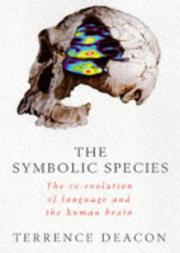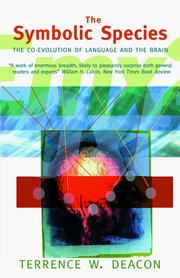| Listing 1 - 9 of 9 |
Sort by
|

ISBN: 0713991887 Year: 1997 Publisher: London : Allen Lane the Penguin press,
Abstract | Keywords | Export | Availability | Bookmark
 Loading...
Loading...Choose an application
- Reference Manager
- EndNote
- RefWorks (Direct export to RefWorks)
Brain --- Neurolinguistics. --- Evolution.
Book
ISBN: 0140264051 Year: 1997 Publisher: London : Penguin books,
Abstract | Keywords | Export | Availability | Bookmark
 Loading...
Loading...Choose an application
- Reference Manager
- EndNote
- RefWorks (Direct export to RefWorks)
Neurolinguistics. --- Brain --- Evolution.
Book
ISBN: 9780393343908 9780393049916 0393049914 Year: 2013 Publisher: New York, N.Y. Norton
Abstract | Keywords | Export | Availability | Bookmark
 Loading...
Loading...Choose an application
- Reference Manager
- EndNote
- RefWorks (Direct export to RefWorks)
Examines the emergent processes that bridge the gap between organisms that think and have consciousness and those that do not and discusses the origins of life, information, and free will.
Cognitive psychology --- Theory of knowledge --- Biogenesis. --- Consciousness --- Life --- Phenomenology --- Brain --- Origin --- Brain. --- Consciousness. --- Phenomenology. --- physiology. --- Origin. --- Life - Origin

ISBN: 9780393317541 0393038386 0393317544 Year: 1998 Publisher: New York, N.Y. Norton
Abstract | Keywords | Export | Availability | Bookmark
 Loading...
Loading...Choose an application
- Reference Manager
- EndNote
- RefWorks (Direct export to RefWorks)
Cerveau --- Neurolinguistique. --- Encéphale --- Langage. --- Évolution (biologie) --- Évolution. --- Physiologie. --- Brain --- Neurolinguistics --- 575 --- Neuro-linguistics --- Biolinguistics --- Higher nervous activity --- Neuropsychology --- 575 General genetics. General cytogenetics. Immunogenetics. Evolution. Speciation. Phylogeny --- General genetics. General cytogenetics. Immunogenetics. Evolution. Speciation. Phylogeny --- Evolution --- Brain - physiology --- Language --- Biological Evolution --- Psycholinguistics
Book
ISBN: 9780231545990 0231545991 9780231173322 0231173326 9780231173339 0231173334 Year: 2018 Publisher: New York, NY
Abstract | Keywords | Export | Availability | Bookmark
 Loading...
Loading...Choose an application
- Reference Manager
- EndNote
- RefWorks (Direct export to RefWorks)
If the universe is aimless, how do selves and aims emerge? Why do living beings have aims when inanimate things do not? Current science encourages us to reject the ghost-in-the-machine explanation-that something called spirit, soul, mind, or will was somehow breathed into matter-and instead accept that selves are just matter, in aimless mechanistic motion like everything else. But what about life's many emergent qualities, the multifarious purposes that shape actual physical behavior not just in human lives, but in all of life? Even the simplest life forms have adaptive functions, traits that accomplish goals or ends. How can we explain the nature and origin of selves and aims without resorting to supernatural forces or explaining them away as nothing but cause-and-effect mechanisms?In Neither Ghost nor Machine, Jeremy Sherman explains the emergence of selves and aims in an aimless universe. He distills for a general audience the theory developed by renowned neuroscientist Terrence Deacon, which extends the breakthrough constraint-based insight that inspired evolutionary, information, and self-organization theory. Emergent dynamics theory provides a testable hypothesis for how mattering arose from matter, function from physics, and means-to-ends behavior from cause-and-effect dynamics. It offers a physics of purpose, demonstrating that there is a strictly physical explanation for the emergence and nature of selves and aims, one that shows our existence in an otherwise inanimate universe is not absurd. Neither Ghost nor Machine bridges the gap between the hard and soft sciences, suggesting fresh and exciting solutions to philosophical mysteries that have perplexed humanity for millennia, from free will to causality to morality.
Consciousness. --- Self-realization. --- Fulfillment (Ethics) --- Self-fulfillment --- Ethics --- Success --- Satisfaction --- Apperception --- Mind and body --- Perception --- Philosophy --- Psychology --- Spirit --- Self
Book
ISBN: 9400723350 9786613697592 9400723369 1280787201 9400795998 Year: 2012 Publisher: Dordrecht [Netherlands] : Springer,
Abstract | Keywords | Export | Availability | Bookmark
 Loading...
Loading...Choose an application
- Reference Manager
- EndNote
- RefWorks (Direct export to RefWorks)
Scientific considerations about the origin of humanity might not be entirely new. However, the articles in this volume present a spectrum/variety of theoretical and disciplinary perspectives which no doubt calls attention and dares to present the span of the problem. The reader is inspired to continuously push and re-think ways of thinking about the themes, instead of fixing and unequivocalizing and is forced to acknowledge a diversity of angles and the need of merging different approaches to achieve further insights on the central theme. The volume succinctly distils frontline research within different subfields by compiling contributions from widely acknowledged academics.
Animal communication. --- Biology -- Semiotics. --- Deacon, Terrence William. --- Deacon, Terrence William. Symbolic species. --- Human evolution. --- Language and languages -- Origin. --- Neurolinguistics. --- Neurolinguistics --- Biology --- Language and languages --- Human evolution --- Animal communication --- Communication --- Biological Processes --- Culture --- Genetic Processes --- Central Nervous System --- Biological Science Disciplines --- Natural Science Disciplines --- Nervous System --- Genetic Phenomena --- Anthropology, Cultural --- Biological Phenomena --- Behavior --- Information Science --- Anatomy --- Behavior and Behavior Mechanisms --- Anthropology --- Phenomena and Processes --- Disciplines and Occupations --- Psychiatry and Psychology --- Social Sciences --- Anthropology, Education, Sociology and Social Phenomena --- Language --- Physiology --- Cultural Evolution --- Brain --- Biological Evolution --- Languages & Literatures --- Human Anatomy & Physiology --- Health & Biological Sciences --- Evolution --- Neuroscience --- Philology & Linguistics --- Semiotics --- Origin --- Historical linguistics. --- Evolution. --- Diachronic linguistics --- Dynamic linguistics --- Evolutionary linguistics --- History --- Life sciences. --- Neurosciences. --- Epistemology. --- Paleontology. --- Evolutionary biology. --- Life Sciences. --- Evolutionary Biology. --- Animal evolution --- Animals --- Biological evolution --- Darwinism --- Evolutionary biology --- Evolutionary science --- Origin of species --- Biological fitness --- Homoplasy --- Natural selection --- Phylogeny --- Fossilogy --- Fossilology --- Palaeontology --- Paleontology, Zoological --- Paleozoology --- Historical geology --- Zoology --- Fossils --- Prehistoric animals in motion pictures --- Epistemology --- Theory of knowledge --- Philosophy --- Psychology --- Neural sciences --- Neurological sciences --- Medical sciences --- Nervous system --- Biosciences --- Sciences, Life --- Science --- Creation --- Emergence (Philosophy) --- Teleology --- Language and history --- Linguistics --- Evolution (Biology). --- Genetic epistemology. --- Paleontology . --- Developmental psychology --- Knowledge, Theory of
Digital
ISBN: 9789400723368 9789400723351 Year: 2012 Publisher: Dordrecht Springer
Abstract | Keywords | Export | Availability | Bookmark
 Loading...
Loading...Choose an application
- Reference Manager
- EndNote
- RefWorks (Direct export to RefWorks)
Theory of knowledge --- General palaeontology --- Evolution. Phylogeny --- Neuropathology --- neurologie --- epistomologie --- Europees recht --- kennisleer --- paleontologie
Book
ISBN: 9789400723368 9789400723351 Year: 2012 Publisher: Dordrecht Springer Netherlands
Abstract | Keywords | Export | Availability | Bookmark
 Loading...
Loading...Choose an application
- Reference Manager
- EndNote
- RefWorks (Direct export to RefWorks)
Scientific considerations about the origin of humanity might not be entirely new. However, the articles in this volume present a spectrum/variety of theoretical and disciplinary perspectives which no doubt calls attention and dares to present the span of the problem. The reader is inspired to continuously push and re-think ways of thinking about the themes, instead of fixing and unequivocalizing and is forced to acknowledge a diversity of angles and the need of merging different approaches to achieve further insights on the central theme. The volume succinctly distils frontline research within different subfields by compiling contributions from widely acknowledged academics.
Theory of knowledge --- General palaeontology --- Evolution. Phylogeny --- Neuropathology --- neurologie --- epistomologie --- Europees recht --- kennisleer --- paleontologie
Book

ISBN: 1501510347 1614516413 9781614516422 1614516421 9781614516415 9781614517535 1614517533 Year: 2014 Publisher: Berlin Boston
Abstract | Keywords | Export | Availability | Bookmark
 Loading...
Loading...Choose an application
- Reference Manager
- EndNote
- RefWorks (Direct export to RefWorks)
"This book is published 100 years after the death of the American polymath Charles Sanders Peirce to celebrate the first century of scholarship on his work."--
Semiotics. --- Semeiotics --- Semiology (Linguistics) --- Semantics --- Signs and symbols --- Structuralism (Literary analysis) --- Peirce, Charles S. --- Peirce, Charles Sanders, --- Peirce, C. S. --- Pirs, Charlz S., --- Peirce, Charles Santiago Sanders, --- Pʻo-erh-ssu, --- Pʻo-erh-ssu, Chʻa-li-ssu, --- Purs, Charls, --- Пърс, Чарлс, --- Chaersi Sangdesi Piersi, --- 查尔斯·桑德斯·皮尔斯, --- Charles Sanders Peirce.
| Listing 1 - 9 of 9 |
Sort by
|

 Search
Search Feedback
Feedback About UniCat
About UniCat  Help
Help News
News